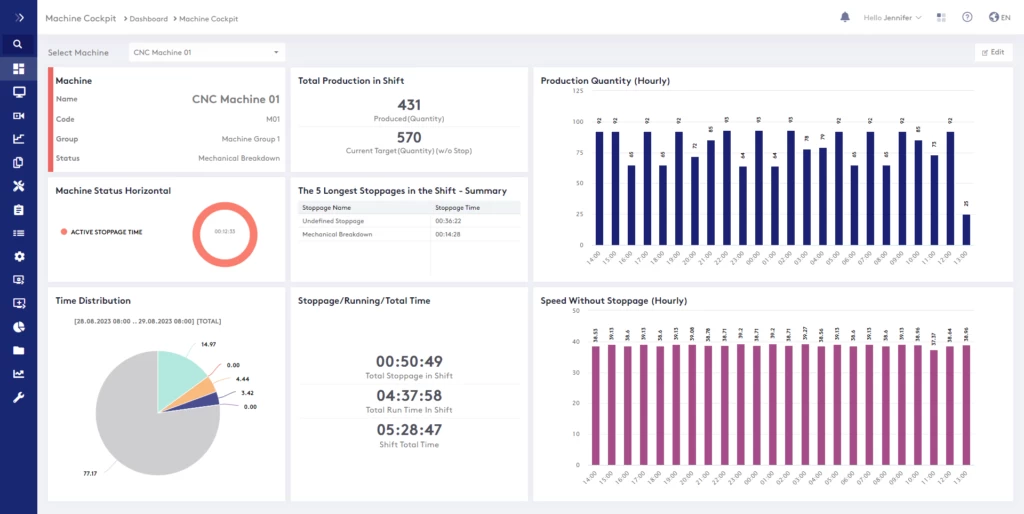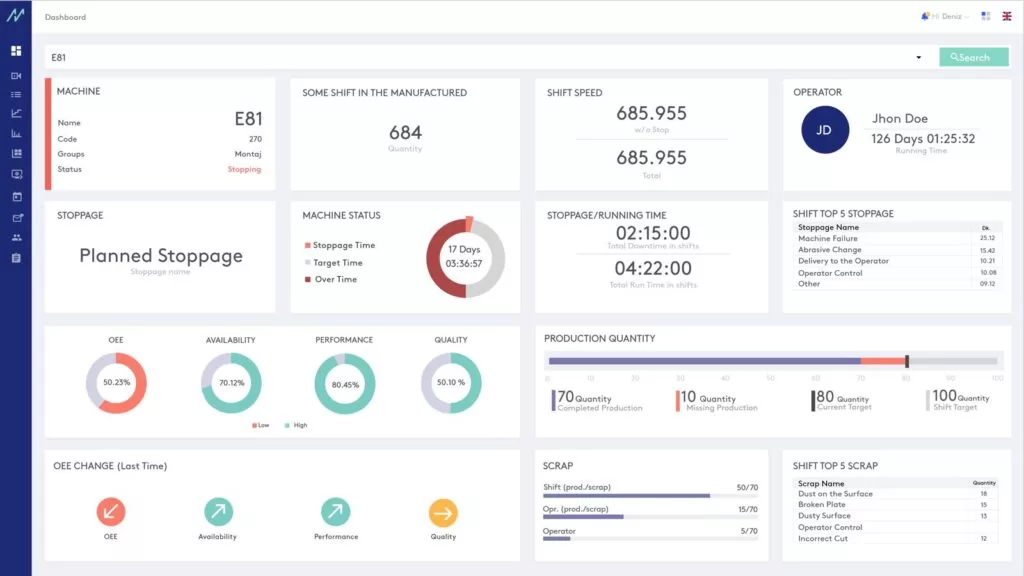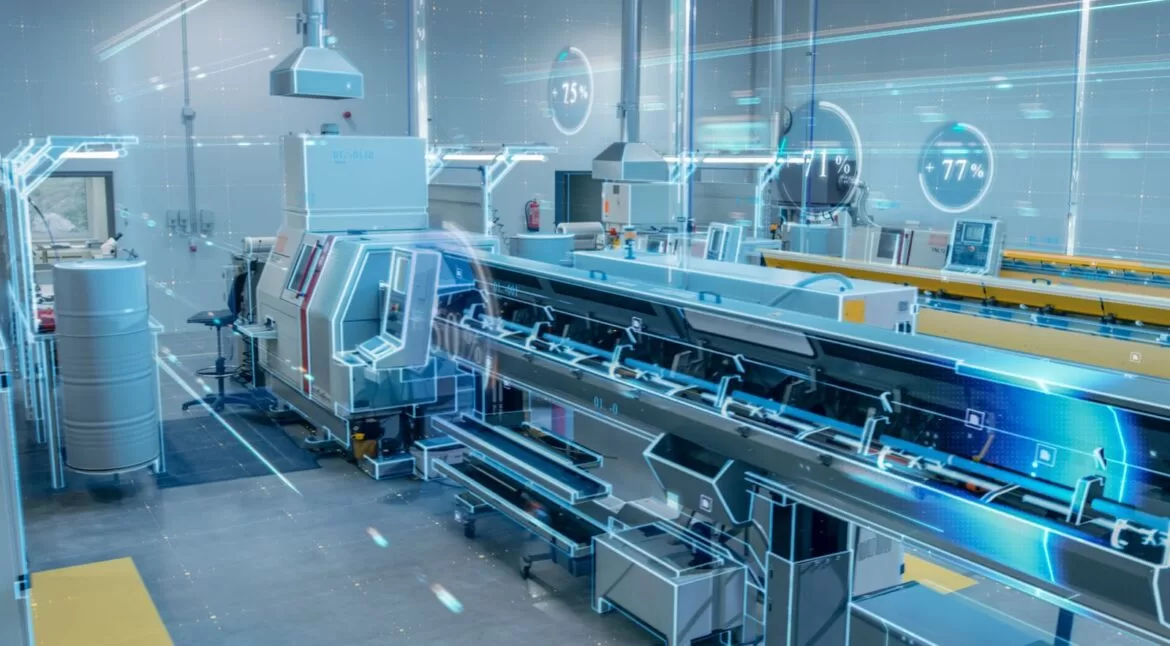We live in a fast-paced business world, where staying competitive means not only having a great product but also making sure it’s produced efficiently and to the highest quality. To achieve that, there’s a game-changing tool that savvy businesses are using to keep their production lines humming smoothly, minimize disruptions, and get the most out of every work hour. We’re talking about production monitoring system. This behind-the-scenes hero works tirelessly, leveraging the latest technology and smart analytics to give businesses a clear window into their operations. So for companies looking to stay ahead, embracing a production monitoring system is not just smart; it’s essential for thriving (and surviving) in today’s complex and ever-changing market landscape.
Let’s dive deeper into understanding everything you need to know about a production monitoring system.
Firstly, What is a Production Monitoring System (PMS)?
Production monitoring has evolved into a sophisticated, real-time digital ecosystem that offers a panoramic view of the manufacturing process. At its core, a real-time production monitoring system is an advanced suite of digital tools designed to keep a constant watch over the various facets of a production line.
This innovative approach surpasses traditional data logging by providing instantaneous feedback on machine performance, process efficiency, and overall production output. It’s a method that enables manufacturers to gain an in-depth understanding of their operations, allowing for immediate identification and resolution of any issues that arise.
Gone are the days when companies relied solely on designated employees to oversee production lines—a practice that, while effective to a degree, offered only a snapshot of the broader production landscape at any given moment. Today’s production monitoring systems offer a dynamic, comprehensive solution, ensuring not just the quality of products but also enhancing operational efficiency and productivity across the board.

Understanding How a Production Monitoring System Works?
Choosing the right tools for optimizing your manufacturing processes is crucial and we’re here to help.
So, a PMS is a sophisticated software solution designed to track and analyze the manufacturing process as it unfolds. It’s engineered to collect, process, and display data from every step of production. By offering real-time insights into vital performance indicators such as production volume, production quality, machine efficiency, machine downtime with pareto analysis, scrap ratio with pareto analysis and it highlights areas ripe for improvement.
In the dynamic world of manufacturing, where meeting production targets and upholding stringent quality standards are non-negotiable, a PMS proves indispensable. It integrates flawlessly with both the machinery on the production floor and the broader network of systems, including programmable logic controllers (PLCs) and enterprise resource planning (ERP) software. This seamless integration allows for a continuous flow of data directly from the source, ensuring that manufacturers have the latest information at their fingertips. Such immediate access to data empowers manufacturers to make swift, informed decisions aimed at enhancing production efficiency and curtailing the risk of expensive operational halts.
Moreover, a PMS is not just about monitoring; it’s about transforming data into actionable intelligence. It facilitates a proactive approach to maintenance, predicting potential machine failures before they occur, and recommending preventive measures. This proactive maintenance can significantly extend the lifespan of machinery, optimize production schedules, and save costs associated with unplanned downtime. Furthermore, by continuously analyzing production data, a PMS can identify patterns and trends, enabling manufacturers to anticipate demand changes and adjust production accordingly. This level of agility is critical in today’s fast-paced market, where consumer preferences and demands can shift rapidly. Ultimately, a production monitoring system is a powerful ally in the quest for manufacturing excellence, driving productivity, enhancing quality, and ensuring a competitive edge in the market.

Benefits of a Real-Time Production Monitoring System
Implementing a real-time production monitoring system offers a multitude of benefits that can significantly enhance the efficiency and quality of manufacturing operations. Let’s discuss key advantages that make real-time production monitoring an invaluable asset for any manufacturing entity.
- Enhanced Efficiency
Real-time production data is a game-changer for identifying and addressing bottlenecks and inefficiencies within the production line. Managers gain the ability to swiftly pinpoint areas that hinder productivity, enabling quick adjustments that lead to smoother operations and a noticeable increase in output. This level of oversight ensures that every part of the manufacturing process is aligned for optimal performance.
- Reduced Downtime
The immediate flagging of issues, such as equipment failures or material shortages, allows for swift interventions. Implementing proactive maintenance based on real-time alerts not only prevents unexpected downtime but also keeps machines operating at their best. This proactive approach translates into considerable cost savings and enhanced operational reliability.
- Improved Quality Control
With real-time monitoring, maintaining high production quality becomes more manageable. It enables the detection of deviations from quality standards as they happen, facilitating prompt corrections. This proactive quality management minimizes the risk of producing defective items, ensuring a consistent and high-quality output that meets customer expectations.
- Data-Driven Decision Making
Access to real-time production data fosters a culture of informed decision-making. Managers can leverage this data to analyze trends, adjust resource allocation, and refine production schedules. This informed approach optimizes resources, enhances production planning, and can significantly improve the bottom line.

- Predictive Maintenance
Continuous monitoring of machine performance uncovers potential issues before they lead to major failures. Predictive maintenance strategies, informed by this data, allow for maintenance to be scheduled at convenient times, reducing downtime and extending the lifespan of equipment.
- Improved Employee Performance
Real-time PMS also sheds light on workforce productivity. Insights into individual or team performance can inform training initiatives and highlight areas where additional support is needed. This focus on employee development fosters a more engaged, efficient, and productive workforce.
The Importance of Production Monitoring in Manufacturing
Enhancing Visibility and Control
One of the primary benefits of production monitoring is the enhanced visibility it provides into the manufacturing process. By capturing real-time data from machines, sensors, and production lines, these systems offer a comprehensive view of the entire operation. Manufacturers can now monitor key performance indicators (KPIs) such as production output, quality metrics, and machine utilization in real-time, enabling them to identify issues and address them promptly.
This level of visibility also empowers manufacturers to take control of their operations. With the ability to track and analyze every stage of the production process, they can make data-driven decisions, optimize resource allocation, and implement targeted improvements to drive efficiency.
Driving Continuous Improvement
Production monitoring systems are not merely passive data collectors; they are powerful tools for driving continuous improvement. By providing detailed insights into the manufacturing process, these systems enable manufacturers to identify areas of waste, inefficiency, and quality issues. Armed with this information, they can implement lean manufacturing principles, streamline workflows, and continuously refine their processes to enhance productivity and profitability.
Moreover, the real-time nature of production monitoring allows for proactive problem-solving. Manufacturers can quickly detect and address issues before they escalate, minimizing downtime, reducing scrap, and improving overall equipment effectiveness (OEE).
Enhancing Collaboration and Decision-Making
Production monitoring systems act as a central hub for manufacturing data, fostering collaboration and informed decision-making across the organization. By integrating these systems with enterprise resource planning (ERP) and other business systems, manufacturers can ensure seamless data flow and break down silos between departments.
This integrated approach empowers managers, operators, and quality teams to access the same real-time information, enabling them to make collective, data-driven decisions. This collaborative environment not only improves operational efficiency but also enhances cross-functional communication and problem-solving.
Key Features of Effective Production Monitoring Systems
Real-Time Data Collection and Visualization
At the core of a robust production monitoring system is the ability to collect and visualize data in real-time. This feature allows manufacturers to stay informed about the current state of their operations, identify issues as they arise, and respond swiftly to mitigate the impact.
Real-time data collection ensures that manufacturers have access to accurate and up-to-date information, enabling them to make timely decisions and take corrective actions. Furthermore, the ability to visualize this data through intuitive dashboards and reports enhances the user experience and facilitates data-driven decision-making.
Scalability and Flexibility
As manufacturing operations evolve and expand, the production monitoring system must be able to adapt and scale accordingly. Scalable and flexible systems allow manufacturers to easily incorporate new production lines, equipment, and facilities without disrupting the existing monitoring processes.
Additionally, the flexibility to customize the system to suit specific business needs is crucial. Manufacturers should be able to define and monitor KPIs that align with their strategic objectives, ensuring that the system provides actionable insights tailored to their unique requirements.
Seamless Integration and Connectivity
Effective production monitoring systems must be able to integrate with a wide range of manufacturing equipment, sensors, and enterprise systems. This connectivity ensures a seamless flow of data, eliminating manual data entry and reducing the risk of errors.
By integrating with ERP, MES (Manufacturing Execution Systems), and other business systems, production monitoring solutions enable manufacturers to gain a holistic view of their operations. This integration facilitates better decision-making, as data from various sources can be consolidated and analyzed to uncover hidden insights.
User-Friendly Interface and Accessibility
The user experience of a production monitoring system plays a crucial role in its adoption and effectiveness. A well-designed, intuitive interface empowers operators, managers, and executives to access, interpret, and act on the available data with ease.
Intuitive dashboards, customizable reporting, and mobile accessibility allow users to quickly navigate the system and extract the information they need. This user-friendliness not only enhances productivity but also fosters a culture of data-driven decision-making throughout the organization.
Leveraging Production Monitoring for Operational Excellence
Improving Overall Equipment Effectiveness (OEE)
One of the key metrics that production monitoring systems can help manufacturers track and optimize is Overall Equipment Effectiveness (OEE). OEE is a comprehensive measure of how effectively a manufacturing operation is utilized compared to its full potential, taking into account availability, performance, and quality.
By providing real-time visibility into machine utilization, production rates, and quality data, production monitoring systems enable manufacturers to identify and address the root causes of OEE losses. This, in turn, allows them to implement targeted improvements and drive continuous optimization of their production processes.

Reducing Downtime and Maximizing Uptime
Unplanned downtime is a significant drain on manufacturing productivity and profitability. Production monitoring systems play a crucial role in mitigating downtime by providing early warning signals and enabling proactive maintenance.
These systems can detect anomalies in machine performance, identify potential failures, and trigger alerts to the appropriate personnel. This allows manufacturers to address issues before they escalate, reducing unplanned downtime and maximizing machine uptime. Additionally, the data collected can be used to develop predictive maintenance strategies, further enhancing equipment reliability and availability.
Improving Quality and Reducing Scrap
Maintaining high product quality and minimizing scrap are essential for manufacturers to remain competitive and meet customer expectations. Production monitoring systems offer valuable insights into the quality of the manufacturing process, enabling manufacturers to identify and address quality issues in real-time.
By tracking quality metrics, such as the number of defective parts or the rate of scrap, production monitoring systems empower manufacturers to take immediate corrective actions. This not only reduces waste and improves overall product quality but also enhances customer satisfaction and brand reputation.
Optimizing Resource Allocation and Inventory Management
Effective resource allocation and inventory management are critical for manufacturing operations to run smoothly and profitably. Production monitoring systems provide valuable data on machine utilization, production rates, and inventory levels, allowing manufacturers to make informed decisions about resource deployment and inventory optimization.
By analyzing this data, manufacturers can identify underutilized assets, optimize production schedules, and ensure that the right resources are available at the right time. This, in turn, leads to improved inventory accuracy, reduced carrying costs, and enhanced responsiveness to customer demands.
Driving Continuous Improvement and Innovation
Production monitoring systems don’t just provide a snapshot of current operations; they also serve as a powerful tool for driving continuous improvement and innovation. By analyzing historical data and identifying patterns, manufacturers can uncover opportunities for process optimization, waste reduction, and technological advancements.
This data-driven approach to continuous improvement empowers manufacturers to stay ahead of the curve, adapt to changing market demands, and maintain a competitive edge. Moreover, the insights gleaned from production monitoring can inform strategic decision-making, enabling manufacturers to invest in the right technologies, processes, and talent to drive long-term growth and innovation.
ProManage Cloud symbolize an advancement, in management and supervision. By utilizing its cutting edge platform ProManage Cloud effectively merges technology with user interfaces empowering companies to enhance their production processes with exceptional efficiency and accuracy. With its real time monitoring features ProManage Cloud offers insights into all production aspects from equipment performance to resource utilization enabling decision making and prompt responses to operational issues. Additionally its cloud based structure guarantees accessibility from any location promoting collaboration among teams and stakeholders. ProManage Cloud and its Production Monitoring System serve as evidence of the progress in Industry 4.0 equipping businesses, with the tools to succeed in a rapidly changing and competitive environment.

In today’s time of smart manufacturing, a real-time production monitoring system is not just a tool but a strategic asset. By leveraging the power of real-time data, manufacturers can achieve unparalleled operational efficiency, superior quality control, and a competitive edge in the global market.
If you want to know more about how you can transform old manufacturing into a more efficient and proactive ecosystem, please contact ProManage today to discuss the right solution. Let’s help you embrace digital transformation with ease.
Frequently asked questions about production monitoring
What is production monitoring?
Monitoring production involves observing and measuring the production processes while they are occurring to ensure efficiency and quality in some ways. It typically consists of looking at how machines are performing, how productive the workers currently are, and monitoring quality indicators.
Why is production monitoring important?
Effective monitoring helps in the identification of the problems well in advance, reduces downtime, maintains quality, and optimizes resource utilization. All this is very vital for cost control and achieving production targets, therefore, translating into overall efficiency in operations.
What kinds of technologies are utilized for monitoring production processes?
Various technologies such, as sensors and Internet of Things (IoTs) along with A set of technologies comprising sensors and Internet of Things (IoTs), as also Manufacturing Execution Systems-MES, and data analysis tools used for gathering in real-time information on machine status, production rate, and environmental factors.
How does overseeing production enhance quality assurance measures?
In essence, fashioning monitoring is a means of actualizing up-to-date information and valuable insights in real-time, through which flaws or deviations in processes that allow producers to make quick changes can be pinpointed in order to reduce the generation of waste while maintaining product quality.
Can keeping track of production assist in minimizing delays?
Adequate production monitoring effectively avoids breakdowns through machine health monitoring and keeping track of usage and maintenance schedules. Furthermore, analytics can be used for the advance detection of impending faults to take proactive maintenance measures.

